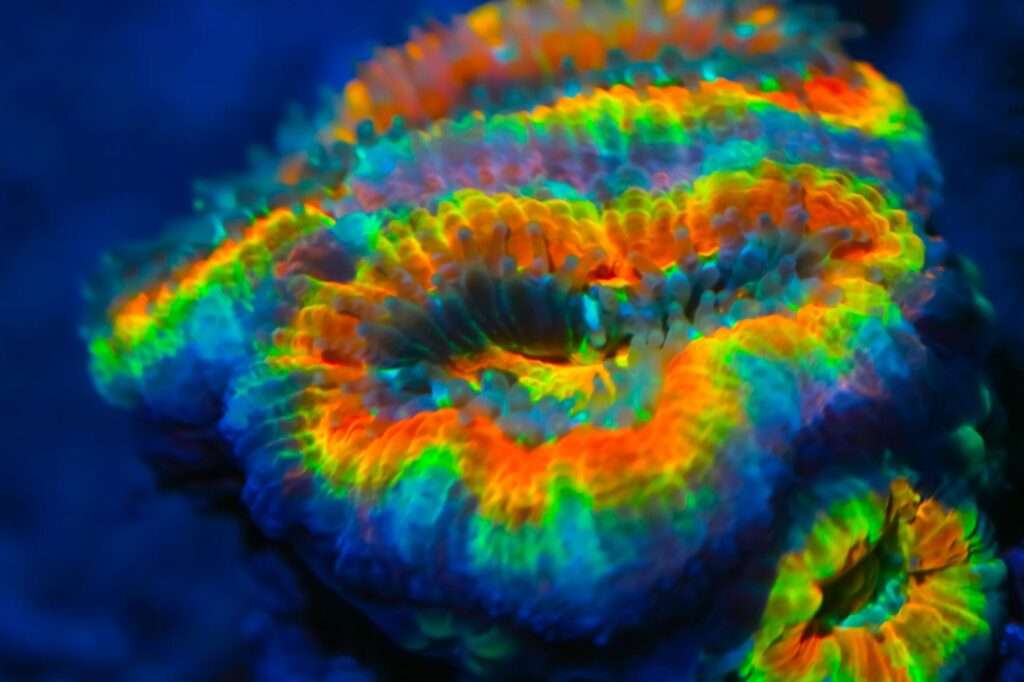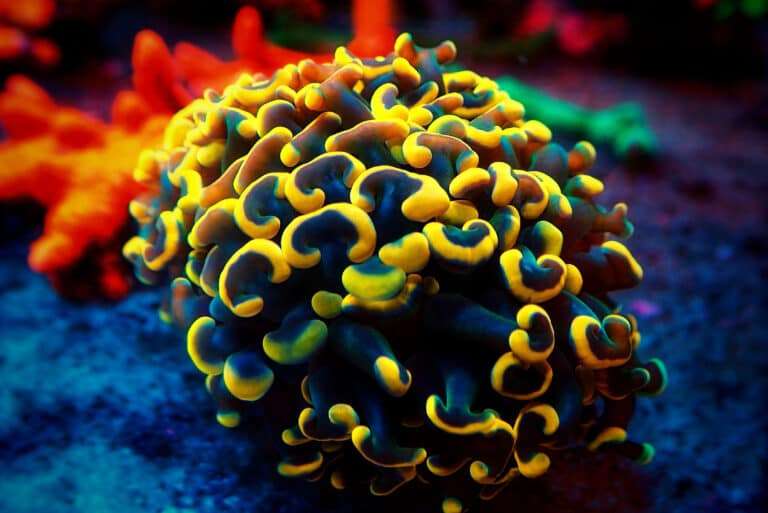
The exquisite large polyp stony (LPS) coral Trachyphyllia radiata is the spectacular Pacific Rose Coral. Large fleshy mantles known as polyps are present on these organisms. They can be various colors of dazzling metallic green, red, or pink. Trachyphyllia geoffroyi is extremely similar to this coral, however it is always clearly circular and typically has a more folded appearance. Its valley walls are fused, as opposed to the Open Brain’s, and it has a flat bottom as opposed to a cone-shaped one.
They live in deeper waters that are between 98 and 131 feet (30 and 40 meters) deep and are shaded by overhangs.
Habitat
The Pacific Rose Corals form colonies and are constantly observed sticking to a solid substrate. They inhabit deeper waters that are shadowed by overhangs and range in depth from 98 to 131 feet (30 to 40 meters). Contrarily, the T. geoffroyi is generally found alone and free on a reef base in seagrass beds or muddy or sandy bottoms. Deeper waters, between 98 and 131 feet (30 and 40 meters) deep, with shady overhangs are where the T. radiata can be found. According to reports, they establish colonies and are always discovered connected to a hard substrate. The T. geoffroyi is typically found in muddy lagoons, reef slope bottoms, and inter-reef habitats with gradual water flow and moderate light, not on reefs.
Morphology
The Open Brain Coral (T. geoffroyi) and the Pacific Rose Coral (T. radiata) are quite similar, however the former is always clearly round rather than flat, and the latter is typically more folded in shape. As they mature, they grow in colonies. The T. geoffroyi forms free-living polyps with valleys that have their own corallite walls, as opposed to the T. radiata, which has fused walls. The Pacific Rose coral has a flattened bottom that is anchored to hard substrate, as opposed to the cone-shaped bottom found in T. geoffroyi, which was employed to anchor itself into soft substrates. Large fleshy mantles known as polyps are present on these organisms. They can be various colors of dazzling metallic green, red, or pink. The breadth of the valleys on Trachyphyllia corals is just under 1/2″ (10 mm), despite the fact that their mouths, which can have up to three separate ones, can measure up to just over 3″ (8 cm) across. Under the flesh, the corallite’s interior wall’s septa, or “teeth,” are massive and resemble ridges. The Trachyphyllia corals extend their polyp tentacles at night to feed. Although they can live a long time in captivity, it is uncertain how long they actually live.
In Captivity

- Feeding
The Trachyphyllia genus has evolved a number of feeding techniques. They get some of their nutrients from a marine alga called zooxanthellae through a symbiotic interaction. Along with food particles from the water column, they can also consume dissolved organic substances, planktonic organisms, and other organisms. T. radiata will extend its tentacles throughout the day if it finds food in the water, but it can only be fed in captivity at night when they are extended. The animal will “accept” larger chunks than a regular mysis but will subsequently regurgitate them up since they are not digestible. Therefore, utilize smaller feeds to prevent your coral from wasting away in less than a year.
- Social Interactions and Compatibility
There are no sweeper tentacles in the Trachyphyllia genus, which is calm. Leather corals will occasionally harm the Trachyphyllia if the water is not properly filtered and carbon is not used to lessen the pollutants these corals release. This coral has been known to be bit by some tangs and angelfish.
Table





